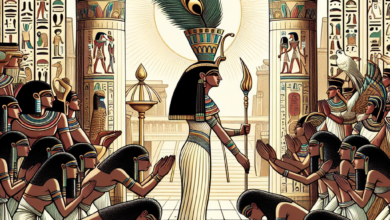Unraveling the Mysteries of Ancient Egyptian Mythology
The ancient Egyptians had a rich and complex mythology that played a central role in their religious beliefs and practices. These myths were passed down through generations, often changing and evolving over time, making them difficult for modern scholars to fully understand. However, through the study of ancient texts, artifacts, and archaeological findings, we have been able to start unraveling the mysteries of ancient Egyptian mythology.
One of the most prominent features of Egyptian mythology is the plethora of gods and goddesses that were worshiped by the ancient Egyptians. These deities represented various aspects of nature, the cosmos, and human life, and were often depicted in human or animal form. For example, Ra was the sun god, depicted as a man with a falcon head, while Hathor was the goddess of love and joy, often depicted as a cow or with cow horns.
Each god and goddess had their own specific roles and responsibilities, and were often associated with certain animals, symbols, and rituals. For example, Anubis, the god of embalming and the afterlife, was often depicted with the head of a jackal, as jackals were commonly seen around cemeteries. Similarly, Bastet, the goddess of protection and cats, was often depicted as a lioness or as a woman with the head of a lioness.
In addition to gods and goddesses, the ancient Egyptians also believed in a variety of other supernatural beings, such as demons, spirits, and monsters. These beings were often seen as malevolent forces that needed to be appeased or defeated through various rituals and offerings. For example, the demon Apep was believed to be a serpent who threatened to destroy the sun god Ra every night, and had to be defeated by the god Set in order for the sun to rise again.
Another important aspect of Egyptian mythology was the concept of the afterlife. The ancient Egyptians believed that the soul was immortal and would continue to exist in the afterlife, where it would be judged by the god Osiris. Those who lived a virtuous life would be rewarded with eternal life in the Field of Reeds, while those who had sinned would be punished or destroyed. This belief in the afterlife led to the development of complex burial practices, such as mummification and the construction of elaborate tombs and funerary monuments.
The myths and stories of ancient Egyptian mythology were often intertwined with the daily lives of the ancient Egyptians, influencing their beliefs, practices, and rituals. For example, the myth of Isis and Osiris, one of the most well-known Egyptian myths, was believed to explain the cycle of life, death, and rebirth. In this myth, Osiris, the god of the afterlife, was murdered by his brother Set, but was resurrected by his wife Isis and went on to become the ruler of the underworld. This story was often reenacted in rituals and festivals, symbolizing the hope for eternal life and the power of love and resurrection.
Despite the vast amount of information we have about ancient Egyptian mythology, there are still many mysteries and unanswered questions that continue to intrigue scholars and researchers. For example, the origins of certain gods and goddesses, the meanings of specific symbols and rituals, and the connections between different myths and stories are still subject to debate and interpretation.
One of the challenges in unraveling the mysteries of ancient Egyptian mythology is the fact that much of our knowledge comes from sources that were written thousands of years ago, and were often influenced by political, religious, and cultural factors. Many of these texts were written by priests and scribes who had their own agendas and biases, and may have added or changed details to suit their own purposes. In addition, as the myths were passed down orally for many generations before being recorded, there were inevitably changes and variations made to the stories along the way.
Despite these challenges, modern scholars have made significant progress in understanding and interpreting ancient Egyptian mythology through the study of texts, artifacts, and archaeological findings. For example, the discovery of the Rosetta Stone in 1799, which contained inscriptions in three different languages (Greek, Egyptian hieroglyphs, and Demotic), allowed scholars to decipher the ancient Egyptian language and unlock the meanings of many previously unintelligible texts.
Through the study of ancient Egyptian mythology, we have gained valuable insights into the beliefs, values, and practices of one of the most fascinating ancient civilizations in history. The myths and stories of the ancient Egyptians continue to captivate and inspire us today, providing a window into the spiritual and cultural world of a people who lived thousands of years ago. As we continue to unravel the mysteries of ancient Egyptian mythology, we can further appreciate the beauty and complexity of a civilization that has left an indelible mark on world history.






